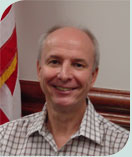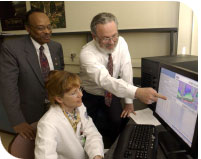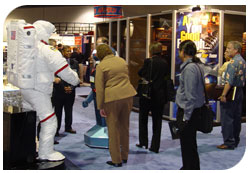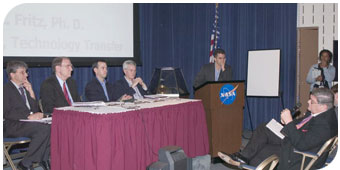|
|||||||||||||||||||||||||||||||||||
 |
|||||||||||||||||||||||||||||||||||
| volume 2, number 2 : fall 2004 |
[Download free Acrobat Reader] |
||||||||||||||||||||||||||||||||||
| Contents: the tech transfer process: researcher profile: events: Upcoming: Tech Transfer Metrics - April 1 - June 30, 2004 |
Recursive Hierarchical Segmentation Software (RHSEG) Improving Medical Diagnoses
We know that space program technologies can play an important role in the U.S. economy and Dr. James Tilton’s (Code 935) Recursive Hierarchical Segmentation Software (RHSEG) technology does that and more. Recent licensing of the technology has resulted in a product that can both speed up and improve medical diagnoses, resulting in more timely and accurate treatment. The RHSEG technology offers an approach to image analysis that looks at sets of hierarchically related regions of an image as opposed to individual pixels. After licensing HSEG (the predecessor of RHSEG), Bartron Medical Imaging, LLC has developed a device (Med-Seg™) that gives medical professionals more detailed image information for digitized scans such as MRI, CT, PET, ultrasound, mammograms, dental x-rays, etc., resulting in quicker, more accurate, and more definitive diagnoses. Because of the RHSEG segmentation approach, medical professionals can now “see” images that were not previously visible to the human eye. Med-Seg™ can also isolate a segment of the image that is of specific interest and compare it to many reference images. Bartron learned of HSEG at NASA’s New Partnerships in Medical Diagnostic Imaging Workshop in 2001. Bartron viewed HSEG as key to differentiating difficult-to-see details from a complex matrix background. They worked closely with the Innovative Partnerships Program (IPP) Office and NASA’s Northeast Regional Technology Transfer Center, the Center for Technology Commercialization to license HSEG/RHSEG. The RHSEG technology was originally designed for Earth remote-sensing applications but as mentioned above, can be highly beneficial in many imaging applications." |
||||||||||||||||||||||||||||||||||
|
Goddard’s Award Winners Recently, six Goddard inventions won awards. Four technologies won NASA Space Act Board Awards for their significant scientific and technical contributions. Those included: (All links open new browser windows.)
Two technologies won the Mid-Atlantic Federal Laboratory Consortium (FLC) award. Those technologies are, Dr. James Tilton’s (Code 935) Hierarchical Segmentation Software (HSEG) technology and Russell Carpenter’s (Code 595) (et al) GPS-Enhanced Onboard Navigation System (GEONS/GEODE). |
|||||||||||||||||||||||||||||||||||
|
|
|||||||||||||||||||||||||||||||||||
|
Once the final license or Space Act Agreement has been signed (see the Spring 2004 issue of Goddard Tech Transfer News for more information about negotiating the partnership/license agreement), the Innovative Partnerships Program Office (IPP) announces the “success story” by issuing press releases, putting it on the Web site, getting a Tech Brief feature article, or other trade journal articles. Sometimes there are even videos produced. IPP also seeks awards for the inventor. |
 |
Why does IPP promote technology transfer success stories?
Much can be gained by publicizing the successful transfer of space program technologies to the commercial or academic sectors. First, with a versatile technology, transfers to more than one partner/licensee may be possible. Therefore, announcing the technology’s successful transfer can attract additional interest in the featured technology.
Success stories help demonstrate the value of NASA as a viable source for technology through achieving benefits on Earth as well as the long-term science benefits in space.
How/Where are the success stories announced?
The IPP publishes several documents announcing technology transfer successes. Success stories are announced in a yearly report published each spring and in videos, both of which are made available on OTT’s Web site. Success stories are also submitted to NASA Tech Briefs, Spinoff magazine, and select professional and trade publications.
Additionally, the IPP works with Goddard’s Public Affairs Office to distribute success story information to the media.
What awards would I, as the inventor, be eligible for?
Although many awards are available for innovative technologies themselves, several awards are given that require technology transfer. For example, NASA gives out the Commercial Invention of the Year Award, which includes a monetary award of up to $100,000. Technology transfer awards given by outside organizations include the following:
- R&D 100 Award
- Space Foundation Hall of Fame Award
- Mid-Atlantic Federal Laboratory Consortium Award
- Innovations in Government Award
- Tech Museum Award
For more information about awards visit the IPP Web site.
Do I need to fill out the award application forms?
Because much of the information needed to complete the award application forms is already on file with IPP (starting with the New Technology Report form 1679), IPP will complete the first draft of the award application for your review. While your input on the application is essential, OTT’s goal is to take a minimal amount of your time.
Next issue - Step 6: The Spin-In Process
![]()
researcher profile:
John Kolasinski
 |
Code 565 Education: BSEE, University of Maryland, College Park, MD, 1985 Born: Milwaukee, Wisconsin |
What invention are you currently working to transfer?
Currently, IPP has been assisting me in promoting my adhesive bubble remover, which is a fixture and method that reduces, and potentially eliminates bubbles in adhesives for fiber optics and other applications with similar manufacturing processes.
What has IPP done to introduce your invention to new users?
In April of this year, I presented the technology at a Joint Venture Opportunity Workshop in Rochester, NY sponsored by NASA’s Northeast Regional Technology Transfer Center (RTTC). It was a great networking opportunity for potential partners.
What do you see as the future for your technology?
A really exciting thing about this technology came about because we needed a way to detect bubbles without destroying fiber optic assemblies. We began working on new ways to x-ray fiber optics to check for bubbles in finished assemblies. That led us to some commercial companies such as Bartron Medical Imaging that uses Dr. Jim Tilton’s HSEG technology. Our collaboration with them, along with the University of Albany and an x-ray company in New York (Lawrence Ripak), is now leading to new areas for digital x-rays. This could have implications in detecting breast cancer, examining aerospace parts, and other areas.
Any advice for your colleagues?
My advice to other inventors is to remember you are most familiar with your technology. Take the time to write the invention disclosure. (They get easier after the first one.) Work with the IPP and participate with marketing efforts. I regularly attend standards meetings and conferences and present my technology when possible. I am essentially working for the IPP helping them transfer NASA products. We all benefit from it.
Events
Goddard Participates in SAMPE’s 60th Anniversary at the 2004 SAMPE Conference
|
|
This year marked the 60th anniversary of the Society for the Advancement of Material and Process Engineering (SAMPE). The annual conference, held May 16-20, in Long Beach, CA, welcomed 4900 attendees from industry, academia, and government labs, all seeking cutting edge information in advanced materials, nanotechnologies and polymeric nanocomposites.
At a NASA-sponsored luncheon, keynote speaker Dr. Harley Thronson, Director of Technology in the Office of Space Science at NASA Headquarters, spoke on NASA’s latest accomplishments. While his focus was on NASA’s two rovers on the surface of Mars and the exciting discoveries yet to be made, he also laid out NASA’s bold new vision for exploring our Solar System and beyond.
The GSFC IPP highlighted several technologies at the NASA booth. Two of these technologies, the Real Time Parylene Sensor and the Adiabatic Demagnetization Refrigerator (ADR), generated specific interest, which the IPP is actively pursing.
High Interest at Goddard’s First Venture Capital Project Workshop
To foster development of high impact collaborations as well as help build inventor interest in technology transfer partnerships, Goddard hosted a Venture Capital Project Workshop. Held on June 29th at the NASA Goddard Visitor Center, the event was cosponsored by the University of Maryland (UMD) Office of Technology Commercialization (OTC) and the R.H. Smith School of Business.
|
|
Speakers at the event included three VCs (Novak Biddle Venture Partners, SpaceVest, and New Markets Growth Fund), Maryland Technology Development Corporation (TEDCO), representatives from the UMD Technology Commercialization Office, and GSFC personnel including: Nona Cheeks, Chief, NASA Goddard Innovative Partnerships Program Office; Owen Barwell, NASA Enterprise Engine; John Fini, NASA Technology Transfer Incubator (Emerging Technology Center); Jonathan Root, NASA Program Executive, Innovative Partnerships Program Office; and Bryan Geurts, Patent Attorney, Office of Patent Counsel.
Through several panel discussions, the workshop presented to 87 attendees (48 Goddard inventors) topics ranging from partnering with start-up companies to investing in technology development.
NASA Technology Transfer Investment Workshop, October 29, 2004, Greenbelt Marriott, Greenbelt, MD
This workshop is an opportunity for GSFC researchers to further explore investment with angel, seed, and venture capital experts. The objective is to establish working relationships and provide attendees with valuable information to attract high-impact collaborations for their technology. One of the main goals is to accelerate the utilization of NASA technology throughout the region through partnerships with the investment community.
NASA Tech Briefs Nano 2004 Conference, November 11 & 12, Wyndham, Baltimore, MD
Tech Briefs’ second annual nanotechnology conference will focus on the latest “small tech” innovations developed at NASA and other U.S. federal laboratories. This venue will provide opportunities to learn about potential funding and partnering, as well as to network with influential players in the nanotechnology arena. Experts from various federal labs, universities and companies will discuss the trends in R&D and provide insight on nanotech’s true market potential. °
![]()
Tech Transfer Metrics
April 1 to June 30, 2004
New technologies reported: 32
New technologies were reported by the following civil servants, contractors, and universities:
Civil Servants
|
Code 600John Keller: 3-Dimensional Solid Models of Scientific Data for Education and Outreach Code 700Farhad Tahmasebi: Three Degree-of-Freedom Parallel Manipulator with Three Inextensible Limbs and Base-Mounted Actuators Code 900Paul Houser: Land Information System Version 2.0 Software Contractors:Aker Industries Universities:Johns Hopkins University/Applied Physics Lab |
Licenses/Partnerships: 2
|
|
Issues Patents: 3Innovators receive a $500 to $1,000 award for an issued patent.
Patent Applications Filed: 1
|
|
|
Provision Patents Filed: 8
|
|
We want to do all we can to make it easy and rewarding for you to participate in the Technology Transfer Program. But we need your help. Send us your ideas for program improvements or News articles via email.
![]()
You can report new project technologies by submitting the online form on eNTRe.
![]()
A publication of
Innovative Partnerships Program Office
Mailstop 504
Building 22, Room 290
(301) 286-5810
techtransfer@gsfc.nasa.gov
![]()
+ Freedom of Information Act + The President's Management Agenda + Privacy Policy and Important Notices + Freedom to Manage |
Webmaster: Adil Anis NASA Official: Nona Cheeks Last Updated: June 25, 2012 + Contact NASA |
||



